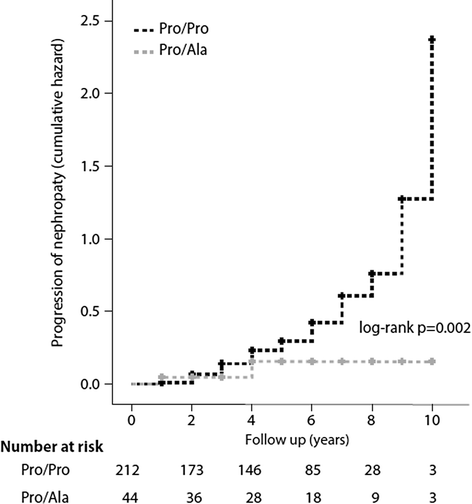The PPARγ2 Pro12Ala variant is protective against progression of nephropathy in people with type 2 diabetes
- PMID: 25889595
- PMCID: PMC4358785
- DOI: 10.1186/s12967-015-0448-6
The PPARγ2 Pro12Ala variant is protective against progression of nephropathy in people with type 2 diabetes
Abstract
Objective: Cross-sectional studies suggest the association between diabetic nephropathy and the PPARγ2 Pro12Ala polymorphism of the peroxisome proliferator-activated receptor γ2 (PPARγ2). Prospective data are limited to microalbuminuria and no information on renal function is available to date. The present study evaluates the association between the Pro12Ala polymorphism of PPARγ2 and the progression of albuminuria and decay in glomerular filtration rate (GFR) in type 2 diabetes.
Patients and measurements: We studied 256 patients with an average 5-year follow-up. Among others, urinary albumin excretion rate (UAER) was measured on spot sample, GFR was estimated with the CKD-EPI Equation.
Results: Baseline UAER and GFR were similar for carriers or non-carriers of the polymorphism. At follow-up no significant changes from baseline were observed for UAER or eGFR in carriers of the Pro12Ala polymorphism whereas a significant increase in UAER [17 (11.3-37.9) versus 24.5 (13.8-49.9) μg/mg, p < 0.006)] and a significant reduction in the eGFR (82.8 ± 14.5 versus 80.3 ± 17.3 ml/min/1.73, m(2) p = 0.02), were observed in non carriers of the Pro12Ala polymorphism. Progression of nephropathy - defined according to a combined end point of UAER and eGFR- i.e. doubling of baseline UAER to at least 100 μg/mg, or new onset microalbuminuria, or progression from micro to macroalbuminuria, or 25% reduction of eGFR, or annualized eGFR decline >3 ml/min/year - was significantly less frequent in Ala carriers than non carriers (11.4% vs 35.8%; p < 0.01); HR adjusted for baseline age, AER, eGFR, HbA1c, diabetes duration and blood pressure was 0.32 (0.12-0.80).
Conclusions: This study found that among patients with type 2 diabetes, the PPARγ2 Pro12Ala polymorphism is protective against progression of nephropathy and decay of renal function independent of major confounders.
Figures
Similar articles
-
Association between Pro12Ala polymorphism and albuminuria in type 2 diabetic nephropathy.J Diabetes Investig. 2020 Jul;11(4):923-929. doi: 10.1111/jdi.13208. Epub 2020 Feb 23. J Diabetes Investig. 2020. PMID: 31912623 Free PMC article.
-
Peroxisome proliferator activated receptor γ2 gene Pro12Ala gene polymorphism in type 2 diabetes and its relationship with diabetic nephropathy.Clin Lab. 2014;60(5):743-9. doi: 10.7754/clin.lab.2013.130443. Clin Lab. 2014. PMID: 24839816
-
Impact of the PPAR-gamma2 Pro12Ala polymorphism and ACE inhibitor therapy on new-onset microalbuminuria in type 2 diabetes: evidence from BENEDICT.Diabetes. 2009 Dec;58(12):2920-9. doi: 10.2337/db09-0407. Epub 2009 Aug 31. Diabetes. 2009. PMID: 19720797 Free PMC article. Clinical Trial.
-
The association between the PPARγ2 Pro12Ala polymorphism and nephropathy susceptibility in type 2 diabetes: a meta-analysis based on 9,176 subjects.Diagn Pathol. 2013 Jul 15;8:118. doi: 10.1186/1746-1596-8-118. Diagn Pathol. 2013. PMID: 23856170 Free PMC article. Review.
-
Diabetic kidney disease with and without albuminuria.Curr Opin Nephrol Hypertens. 2011 May;20(3):246-57. doi: 10.1097/MNH.0b013e3283456546. Curr Opin Nephrol Hypertens. 2011. PMID: 21422923 Review.
Cited by
-
Role of TCF7L2 and PPARG2 Gene Polymorphisms in Renal and Cardiovascular Complications among Patients with Type 2 Diabetes: A Cohort Study.Kidney Dis (Basel). 2019 Oct;5(4):220-227. doi: 10.1159/000497100. Epub 2019 Mar 6. Kidney Dis (Basel). 2019. PMID: 31768379 Free PMC article.
-
Nephroprotection by Hypoglycemic Agents: Do We Have Supporting Data?J Clin Med. 2015 Oct 23;4(10):1866-89. doi: 10.3390/jcm4101866. J Clin Med. 2015. PMID: 26512703 Free PMC article. Review.
-
Network biology concepts in complex disease comorbidities.Nat Rev Genet. 2016 Oct;17(10):615-29. doi: 10.1038/nrg.2016.87. Epub 2016 Aug 8. Nat Rev Genet. 2016. PMID: 27498692 Review.
-
Nitrolipids in kidney physiology and disease.Nitric Oxide. 2018 Mar 29:S1089-8603(18)30006-5. doi: 10.1016/j.niox.2018.03.021. Online ahead of print. Nitric Oxide. 2018. PMID: 29605557 Free PMC article. Review.
-
The impact of PPARγ and ApoE gene polymorphisms on susceptibility to diabetic kidney disease in type 2 diabetes mellitus: a meta-analysis.BMC Nephrol. 2024 Nov 30;25(1):436. doi: 10.1186/s12882-024-03859-6. BMC Nephrol. 2024. PMID: 39614174 Free PMC article.
References
-
- Gouda HN, Sagoo GS, Harding AH, Yates J, Sandhu MS, Higgins JP. The association between the peroxisome proliferator-activated receptor-gamma2 (PPARG2) Pro12Ala gene variant and type 2 diabetes mellitus: a HuGE review and meta-analysis. Am J Epidemiol. 2010;15(171(6)):645–655. doi: 10.1093/aje/kwp450. - DOI - PMC - PubMed
Publication types
MeSH terms
Substances
LinkOut - more resources
Full Text Sources
Other Literature Sources
Medical
Research Materials
Miscellaneous


